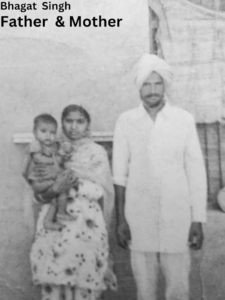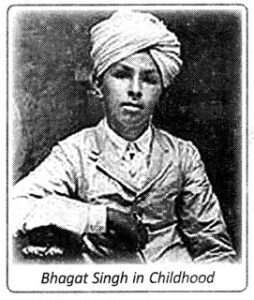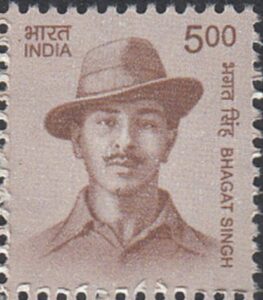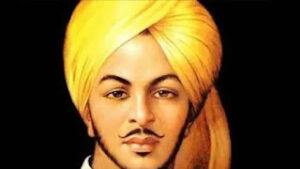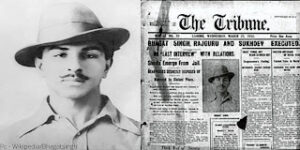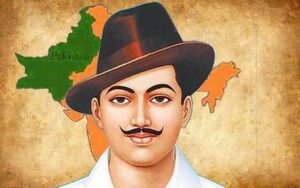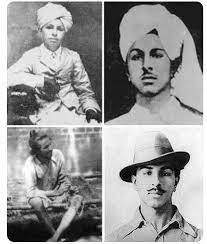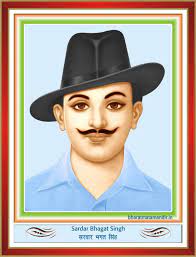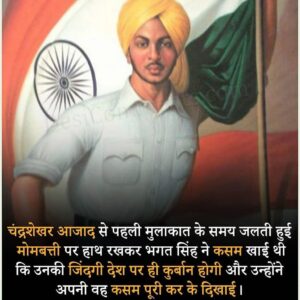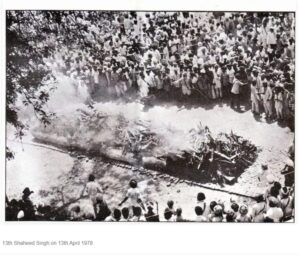A well-known Indian freedom fighter, Bhagat Singh was instrumental in the fight for Indian independence from British colonial control. Born on September 28, 1907, in Punjab, Singh grew up witnessing the oppressive British rule and became deeply involved in revolutionary activities at a young age.
He joined several revolutionary organizations, including the Hindustan Republican Association, and became known for his daring acts against the British government. One of the most notable incidents associated with him was the killing of British police officer John Saunders in 1928, in retaliation for the brutal lathi charge on Lala Lajpat Rai during a protest against the Simon Commission.
Singh became a symbol of resistance and defiance against British imperialism, and his actions inspired countless others to join the struggle for independence. On March 23, 1931, at the age of 23, he was executed by British officials after being apprehended for his involvement in the Saunders case.
Despite his untimely death, Bhagat Singh’s memory has inspired generations of Indians to fight injustice and persecution. His efforts helped India gain independence in 1947, and he is known as a national hero and saint.
Bhagat Singh Education:
Bhagat Singh’s educational journey began at D.A.V. School in Lahore, where he laid the foundation for his academic pursuits. However, it was at National College in Lahore that his educational path intersected with his growing passion for political activism. The college, known for its nationalist sentiments, played a crucial role in shaping Bhagat Singh’s political ideology. His schoolwork took a back seat as he actively participated in student politics and became engrossed in the independence struggle.
Despite his initial focus on academics, Bhagat Singh’s commitment to the cause of India’s independence led him to prioritize revolutionary ideas over traditional educational pursuits. He continued his studies in Lahore, but the political atmosphere and his own convictions gradually steered him away from conventional learning. Bhagat Singh’s decision to forego a conventional academic path was a deliberate choice, driven by a belief in the transformative power of mass awareness and the urgency of the struggle against British colonial rule. His life and actions reflect not only intellectual acumen but also a resolute dedication to the principles of justice and freedom that he considered paramount in the fight for India’s liberation.
D.A.V. School, Lahore:
Bhagat Singh’s early education commenced at D.A.V. School in Lahore, a period that laid the groundwork for his intellectual development. The institution provided a conventional academic setting, but it was during these formative years that Bhagat Singh first encountered the tumultuous political climate of British India. The 1919 Jallianwala Bagh massacre profoundly impacted his developing consciousness and stoked his developing sense of patriotism. Bhagat Singh’s academic interest was piqued at D.A.V. School, where he also started to establish beliefs that would later solidify into a passionate devotion to the cause of India’s independence. This educational setting sowed the seeds of his revolutionary enthusiasm, which helped him subsequently rise to prominence in the fight against colonial control.
National College, Lahore:
Bhagat Singh’s transformative years at National College in Lahore played a pivotal role in shaping his ideological and revolutionary fervor. Established in an environment known for its nationalist sentiments and anti-British stance, the college became a crucible for Bhagat Singh’s burgeoning political consciousness. At National College, he received an education that went beyond textbooks. It became a platform for him to actively engage in student politics and immerse himself in the larger discourse of the Indian independence movement.
The college’s ethos, coupled with the charged atmosphere of the time, intensified Bhagat Singh’s commitment to the cause of freedom. During this period, he evolved from a student with intellectual promise to a passionate activist, laying the groundwork for his subsequent contributions to the struggle against colonial oppression. The crucible of National College not only honed Bhagat Singh’s intellectual acuity but also fueled his determination to challenge the status quo and fight for a liberated India.
Higher Studies in Lahore:
Bhagat Singh’s pursuit of higher studies in Lahore marked a crucial phase in his life, where academic endeavors intersected with his deepening involvement in the Indian independence movement. Although he continued his formal education, his focus gradually shifted towards revolutionary ideals and the urgent call for freedom. Lahore, a city with a rich political and cultural history, provided the backdrop for Bhagat Singh’s intellectual evolution. His higher studies became a platform for exploring and articulating radical political ideologies, reflecting the broader sentiments of the time. Despite his intellectual prowess, Bhagat Singh’s commitment to the cause led him to prioritize revolutionary activism over conventional academic pursuits. This period of his life underscores a deliberate choice to channel his energies into the struggle against British colonial rule. Demonstrating the blend of analytical ability and social passion that would characterize his career in India’s independence struggle.
Influence of Jallianwala Bagh Massacre:
The dreadful Jallianwala Bagh Massacre, which took place in Amritsar on April 13, 1919, had a profound impact on Bhagat Singh, a well-known revolutionary and independence fighter in India. The massacre, orchestrated by General Reginald Dyer, involved the indiscriminate killing of hundreds of unarmed civilians. Who had gathered at Jallianwala Bagh for a peaceful protest against the repressive Rowlatt Act.
The brutality of the massacre left an indelible mark on the psyche of the Indian people, including Bhagat Singh. Witnessing the ruthless use of force by the British authorities against unarmed protesters deeply angered and disturbed him. The incident fueled his commitment to the cause of India’s independence and intensified his resolve to oppose British colonial rule through more radical means.
Jallianwala Bagh became a symbol of the British Empire’s atrocities against Bhagat Singh and other independence fighters. Saw it as a stark reminder of the urgent need for India to break free from colonial shackles. The tragedy inspired a generation of nationalists to oppose the repressive regime and fight for a free and independent India.
Bhagat Singh’s long-standing animosity and bitterness, kindled by events such as the Jallianwala Bagh Massacre, is what led to his involvement in revolutionary operations, including the Lahore Conspiracy Case and his ultimate sacrifice for the cause of independence. The event played a crucial role in shaping the political consciousness of Bhagat Singh and many others, driving them to strive for a liberated India where the principles of justice and equality would prevail.
Bhagat Singh Radicalization:
Bhagat Singh, a significant player in India’s independence movement, was heavily involved in radical actions during his lifetime. Born in 1907, he became increasingly disillusioned with British colonial rule from a young age, witnessing firsthand the injustices and atrocities inflicted upon his fellow countrymen. This environment fueled his fervent nationalism and propelled him towards radicalization.
One of the pivotal moments in Bhagat Singh’s radicalization was the Jallianwala Bagh massacre in 1919. Where British troops opened fire on unarmed civilians in Amritsar, resulting in hundreds of deaths. This brutal incident left an indelible mark on Singh’s psyche. Solidifying his resolve to fight against British oppression through any means necessary.
As he grew older, Bhagat Singh became associated with various revolutionary groups such as the Hindustan Socialist Republican Association (HSRA). Which advocated for complete independence from British rule and employed militant tactics to achieve their goals. Singh’s involvement in activities such as the Lahore Conspiracy Case, the Assembly Bombing case. The killing of British police officer John Saunders underscored his commitment to the cause of freedom.
Despite his young age, Bhagat Singh emerged as a symbol of resistance against colonialism and oppression in India. His radium was motivated by a strong sense of injustice and a robust belief in the rightness of his cause. Despite immediate danger and eventual death, Singh remained loyal to his charges, inspiring others to join the battle for independence.
Ultimately, the unstable sociopolitical environment of colonial India—one marked by tyranny, exploitation, and resistance—formed the basis for Bhagat Singh’s radicalization. His actions and ideologies continue to resonate with generations of Indians, serving as a reminder of the enduring struggle for freedom and justice.
Bhagat Singh Execution:
Bhagat Singh, a prominent figure in India’s struggle for independence, met his untimely end through execution on March 23, 1931. His dedication to the cause of freedom and unconventional approach made him an icon of resistance to British colonial control. Because of his role in the Lahore conspiracy case and the murder of British police officer J.P. Saunders, Bhagat Singh and his companions Rajguru and Sukhdev received death sentences.
As the day of execution approached, Bhagat Singh remained steadfast in his beliefs, refusing to seek clemency. He saw his sacrifice as a means of awakening the masses and inspiring them to fight against injustice. The gallows did not deter his spirit; instead, it amplified his message of courage and determination. On the day of his execution, thousands gathered to witness the end of a young revolutionary’s life. Bhagat Singh’s final words, “Inquilab Zindabad” (Long Live the Revolution), resonated with the onlookers and echoed through the pages of history.
The execution of Bhagat Singh left an indelible mark on India’s struggle for independence. His sacrifice became a symbol of resistance and inspired countless others to join the fight against colonial oppression.
Bhagat Singh Legacy:
Bhagat Singh, an iconic figure in India’s struggle for independence, left behind a profound legacy that continues to inspire generations. His youthful execution did not diminish his revolutionary fervor or his dedication to the cause of freedom. Singh’s fearless actions, including the assassination of British police officer John Saunders and his participation in the bombing of the Central Legislative Assembly in Delhi, marked him as a symbol of defiance against colonial oppression.
His writings, particularly his essays and letters penned during his time in jail, showcase his intellectual depth and unwavering dedication to the ideals of socialism and secularism. He articulated a vision for a just and egalitarian society, free from exploitation and discrimination. Singh’s ideology transcended mere nationalism; he advocated for a radical transformation of Indian society. Challenging not just British rule but also the socio-economic inequalities inherent in the prevailing systems.
Bhagat Singh’s impact goes beyond his actions and words; he represents the spirit of sacrifice and courage in seeking justice. His refusal to plead for mercy during his trial and his acceptance of death with dignity became emblematic of the courage of the Indian freedom fighters. Moreover, Singh’s embrace of martyrdom rather than compromise further solidified his place in the annals of Indian history.
In contemporary India, Bhagat Singh remains a revered figure, celebrated for his courage, intellect, and unwavering commitment to the ideals of freedom and equality. His image adorns posters, his words resonate in speeches, and his life continues to be studied and commemorated in various forms of art and literature. His legacy serves as a reminder of the power of individual resistance against injustice and tyranny, inspiring people worldwide to stand up for their rights and fight against oppression.
Entry into the Independence Movement:
Bhagat Singh, a significant character in India’s freedom struggle, joined the movement at an early age, fervently and determinedly. Singh, who was born into a revolutionary family, was profoundly influenced by colonial India’s sociopolitical environment. His exposure to nationalist ideas and injustices committed by the British fueled his desire to fight for freedom.
Singh’s active involvement in a range of revolutionary activities and organizations signaled his entry into the independence movement. He joined organizations like the Hindustan Republican Association (HRA) and later the Hindustan Socialist Republican Association (HSRA). which advocated for armed struggle against British rule.
His participation in acts of resistance, such as the bombing of the Central Legislative Assembly in 1929. Aimed to shake the foundations of British imperialism and inspire fellow Indians to rise against oppression. Despite facing imprisonment and persecution, Singh remained steadfast in his commitment to the cause of independence.
His revolutionary zeal and fearless attitude made him a symbol of resistance and defiance against colonial rule. Bhagat Singh’s entry into the independence movement was not merely a personal choice but a reflection of his unwavering dedication to the ideals of freedom, justice, and equality for all Indians.
Protest Against Simon Commission:
Bhagat Singh was one of the most prominent figures in the Indian independence movement against British rule. The British government established the Simon Commission in 1927 to explore constitutional reforms in India, but he was adamantly against them. Singh and many other Indian nationalists saw the Commission as an insult to Indian sovereignty because it consisted entirely of British members and did not include any Indian representatives.
In protest against the Simon Commission, Bhagat Singh and his associates organized various demonstrations and acts of civil disobedience. One of the most famous incidents associated with their protest was the bombing of the Central Legislative Assembly in Delhi on April 8, 1929. Bhagat Singh and Batukeshwar Dutt, another revolutionary. Tossed bombs into the assembly to protest harsh laws and to alert the British rulers to the Indian people’s displeasure.
Bhagat Singh’s actions were a bold statement against British rule and a call for greater Indian participation in the governance of their own country. His bravery and sacrifice inspired many people to join the fight for Indian independence, even though he was ultimately detained and put to death by British forces. Bhagat Singh remains a revered figure in India’s history, remembered for his unwavering commitment to the cause of freedom.
Involvement in the Freedom Struggle:
Bhagat Singh was a prominent figure in the Indian freedom struggle against British colonial rule. Historical occurrences such as the 1919 Jallianwala Bagh massacre and Mahatma Gandhi’s Non-Cooperation Movement had a profound impact on him, and he actively participated in the struggle from a young age. The sacrifices made by rebels like Kartar Singh Sarabha and Ram Prasad Bismil particularly inspired Singh.
Singh joined the Hindustan Republican Association (HRA), which later became the Hindustan Socialist Republican Association (HSRA). Began advocating for complete independence from British rule through revolutionary means. He believed in using violence to attain political goals and participated in various acts of resistance against the British government.
Bhagat Singh is well known for his involvement in the Lahore Conspiracy Case, where he and his cronies were accused of killing British police officer John Saunders. Singh and his comrades also bombed the Central Legislative Assembly in Delhi to protest against repressive laws.
Bhagat Singh dedicated his life to the cause of Indian independence and inspired many with his bravery and devotion. He was eventually arrested, tried, and sentenced to death by the British authorities. Despite his young age, Bhagat Singh left a lasting legacy as a symbol of resistance and defiance against colonial oppression.
Lala Lajpat Rai’s Death and Revenge:
Bhagat Singh, Lala Lajpat Rai, and their friends were key figures in the early twentieth-century Indian independence struggle. The death of Lala Lajpat Rai, and Bhagat Singh and his comrades’ ensuing vengeance, was a watershed moment.
In 1928, Lala Lajpat Rai led a protest against the Simon Commission, a British investigative body, in Lahore. The police responded harshly, and during the lathi charge, Rai sustained injuries. He later succumbed to his injuries, leading to widespread outrage among Indians.
Bhagat Singh, Rajguru, Sukhdev, and their group pursued revenge as payback. James A. Scott, the policeman thought to have been behind Lajpat Rai’s death, was attacked on December 17, 1928. But Bhagat Singh and his cronies shot and killed J.P. Saunders, another police officer, in a case of mistaken identity.
The revenge act had significant repercussions. Bhagat Singh and his comrades became fugitives and were eventually arrested. The trial that followed, including the famous Lahore Conspiracy Case, marked a critical juncture in India’s struggle for independence.
Did on March 23, 1931, Bhagat Singh, Rajguru, and Sukhdev received death sentences. While the revenge may not have directly addressed the loss of Lala Lajpat Rai. It intensified the resistance against British rule and inspired many to join the struggle for India’s freedom. In India’s history of freedom, people have continued to honor and commemorate the sacrifice made by these revolutionary leaders.
Role in the Saunders Murder:
Bhagat Singh played a pivotal role in the Saunders murder case, a significant event in the Indian independence movement. On December 17, 1928, Lala Lajpat Rai succumbed to injuries sustained during a protest against the Simon Commission. Seeking revenge, Bhagat Singh and his associates identified James A. Scott, the police officer they believed responsible for Lala Lajpat Rai’s death. But on December 17, 1928, they accidentally killed J.P. Saunders, an Assistant Superintendent of Police, as a result of a case of mistaken identity.
Bhagat Singh’s involvement in the Saunders murder was a turning point in his life and the Indian independence struggle. The incident marked a shift from non-violent protests to more radical forms of resistance. Bhagat Singh and his compatriots saw the use of force as a means to shake the British colonial administration and instigate public awakening. The Saunders murder trial became a symbol of the escalating resistance against British rule, and it laid the foundation for Bhagat Singh’s eventual martyrdom. His activities, as well as the subsequent trials, were essential in encouraging India’s youth to join the independence cause. Bhagat Singh’s dedication to the cause and sacrifice remain a significant symbol of resistance in India’s struggle against colonial authority.
Assembly Bombing and Arrest:
Bhagat Singh, a prominent figure in the Indian independence movement, gained notoriety for his role in the Assembly Bombing incident. On April 8, 1929, in protest against repressive laws and the Trade Disputes Bill, Bhagat Singh and Batukeshwar Dutt threw non-lethal smoke bombs in the Central Legislative Assembly in Delhi. Their objective was not to inflict harm, but to utilize the incident to express their resistance to repressive British policies.
Following the bombing, Bhagat Singh and Batukeshwar Dutt willingly courted arrest to ensure that their message reached a wider audience. During their trial, they used the proceedings to communicate their opinions on colonialism and the importance of India’s independence. Despite the non-lethal nature of the devices, they were charged with attempted murder and condemned to life in prison.
Bhagat Singh’s arrest and subsequent imprisonment catapulted him into the limelight, making him a symbol of resistance against British rule. He will always be regarded as a martyr for the liberation of his country because of his bravery and unwavering commitment to the cause of independence, which marked the Indian people’s collective conscience.
Bhagat Singh Trial:
A pivotal character in India’s freedom movement, Bhagat Singh endured a historic trial that will never be forgotten. Born in 1907, Singh became a fervent revolutionary committed to freeing India from British colonial rule. The trial in question took place in 1930, when Singh participated in a protest against the British government’s restrictive legislation.
During the trial, Bhagat Singh, along with his comrades Rajguru and Sukhdev, conducted themselves with utmost bravery and conviction. They used the courtroom as a platform to articulate their vision of a free and just India. The accused made a powerful statement by refusing to seek clemency, turning the trial into a poignant expression of their commitment to the cause of independence.
The trial proceedings were marked by impassioned speeches, eloquent arguments, and fearless declarations of their revolutionary beliefs. Despite their valiant attempts, Bhagat Singh, Rajguru, and Sukhdev were convicted to death and executed on March 23, 1931. The sacrifice of these young revolutionaries stirred the conscience of the nation and played a crucial role in inspiring future generations to continue the fight for India’s freedom. The Bhagat Singh trial remains a symbol of courage, sacrifice, and unwavering dedication to the ideals of independence.
Hindustan Socialist Republican Association (HSRA):
Bhagat Singh was a prominent revolutionary and a key member of the Hindustan Socialist Republican Association (HSRA) in India. The HSRA was a revolutionary organization formed in 1928 with the aim of overthrowing British colonial rule and establishing a socialist republic in India. Bhagat Singh, along with other like-minded revolutionaries such as Sukhdev Thapar and Shivaram Rajguru, played a crucial role in the activities of the HSRA.
The HSRA was involved in a number of audacious acts against the British government and promoted the use of violence and force to further its objectives. One of the most notable incidents was the assembly bombing in the Central Legislative Assembly in Delhi in 1929. Where Bhagat Singh and Batukeshwar Dutt courted arrest to protest against repressive laws.
Bhagat Singh and his friends believed that martyrdom may inspire the masses and draw attention to the cause of independence. British authorities hanged Bhagat Singh, Rajguru, and Sukhdev in 1931 for their role in the murder of British police officer J.P. Saunders. Their sacrifice had a profound impact on the Indian independence movement and inspired future generations of activists. The HSRA, through its actions and sacrifices, contributed significantly to the struggle for India’s freedom from colonial rule.
Lahore Conspiracy Case:
Bhagat Singh, a pivotal figure in the struggle against British colonial rule, was connected to the Lahore Conspiracy Case. Bhagat Singh is a well-known figure in the Indian independence movement. The case stemmed from the Assembly Bombing incident on April 8, 1929. When Bhagat Singh and his associates threw non-lethal smoke bombs in the Central Legislative Assembly in Delhi. The intention was to protest against repressive laws and demand better conditions for political prisoners.
That being said, the principal focus of the Lahore Conspiracy Case was the police officer J.P. Saunders’s murder on December 17, 1928. Bhagat Singh and his fellow revolutionaries blamed Saunders for the savage lathi assault that killed liberation hero Lala Lajpat Rai. In their quest for vengeance, they chose to destroy Saunders.
Bhagat Singh, along with Rajguru and Sukhdev, were arrested in connection with the murder. During the trial, they used the court as a platform to propagate their revolutionary ideals and beliefs. With their defense pleas and demands for a fair trial, they received a sentence to death. On March 23, 1931, Bhagat Singh, Rajguru, and Sukhdev were assassinated. They later joined the Indian independence fight as soldiers.
The Lahore Conspiracy Case was crucial in rallying public opinion against British rule and motivating future generations of liberation fighters. India’s struggle for freedom has seen symbols of justice and resistance in the form of Bhagat Singh’s martyrdom and the events surrounding the case.
Jail and Hunger Strike:
A key player in the Indian independence struggle, Bhagat Singh was imprisoned for his revolutionary deeds against British tyranny. He participated in a hunger strike with other political prisoners, which was one of the major events of his incarceration.
Bhagat Singh and his friends were taken into custody in 1929 after killing British policeman James A. Scott during the Lahore Conspiracy Case. While in jail, they utilized the platform to protest against the oppressive conditions and demand better treatment for political prisoners.
Bhagat Singh, along with his comrades, initiated a hunger strike on June 15, 1929, to protest against the inhumane conditions of imprisonment and to secure political prisoner status. Their demands included better living conditions, the right to read political literature, and the right to communicate with fellow prisoners.
Both domestically and abroad, the hunger strike attracted a lot of interest and support. But it had a negative impact on Bhagat Singh’s and his friends’ health. The protest lasted for 116 days, with the authorities showing reluctance to meet the demands.
Bhagat Singh persisted in his dedication to the cause despite the physical toll it was taking on his health. On October 5, 1929, an agreement between the convicts and the British authorities brought an end to the hunger strike. Despite the negligible short-term benefits, the hunger strike served as a potent symbol of resistance and fueled the expansion of the Indian independence movement. Bhagat Singh’s sacrifice and commitment to the cause continue to inspire generations of Indians in their quest for justice and freedom.
Bhagat Singh Death:
It seems like your question is incomplete or unclear. If you’re asking for information or details about Bhagat Singh’s death, I’d be happy to provide some information. Bhagat Singh was a prominent Indian freedom fighter who played a significant role in the Indian independence movement. British colonial officials executed him on March 23, 1931, when he was 23 years old. For their roles in the assassination of British police officer James, Bhagat Singh, Rajguru, and Sukhdev received death sentences. A Scott during the Lahore Conspiracy Case.
Known as a martyr who sacrificed his life to secure India’s freedom, Bhagat Singh’s execution had a profound effect on the country’s independence movement. His legacy continues to inspire generations of Indians in their struggle for justice and freedom. If you have any questions about Bhagat Singh’s death, please offer more information.
Bhagat Singh Fact:
Bhagat Singh was a prominent figure in India’s struggle for independence against British colonial rule. He was born on September 28, 1907, in a small village in Punjab, which was then part of British India. Bhagat Singh was inspired by his time’s nationalism and fought for freedom at a young age. He became involved in various revolutionary activities aimed at overthrowing British rule in India.
One of Bhagat Singh’s most noteworthy activities was the bombing of Delhi’s Central Legislative Assembly in 1929. This was a protest against repressive British laws and policies. Bhagat Singh and his associates threw non-lethal bombs in the assembly and deliberately courted arrest to use their trial as a platform to highlight the injustices faced by the Indian people under British rule.
During his trial, Bhagat Singh famously declared, “It is easy to kill individuals but you cannot kill the ideas. Great empires crumbled, while the ideas survived.” He used the courtroom as a stage to propagate his ideas of revolution and freedom. Bhagat Singh never wavered in his commitment to the cause of Indian freedom, even after suffering torture and receiving a death sentence.
The British authorities hanged Bhagat Singh, along with his comrades Rajguru and Sukhdev, on March 23, 1931. Their martyrdom galvanized the Indian masses and became a rallying cry for the freedom movement. Bhagat Singh’s legacy continues to inspire generations of Indians to fight against oppression and injustice. He is remembered as a daring revolutionary who gave his life for the sake of his country’s liberty.


